Services on Demand
Article
Indicators
Related links
-
 Cited by Google
Cited by Google -
 Similars in Google
Similars in Google
Share
Journal of the South African Institution of Civil Engineering
On-line version ISSN 2309-8775
Print version ISSN 1021-2019
J. S. Afr. Inst. Civ. Eng. vol.57 n.3 Midrand Sep. 2015
http://dx.doi.org/10.17159/2309-8775/2015/V57N3A3
TECHNICAL PAPER
Performance assessment of aquatic macrophytes for treatment of municipal wastewater
M Shah; H N Hashmi; A R Ghumman; M Zeeshan
ABSTRACT
The objective of the study was to evaluate the performance of three different aquatic macrophytes for treatment of municipal wastewater collected from Taxila in Pakistan. A physical model of a typical treatment plant was constructed and was operated for six experimental runs with each species of macrophyte. Every experimental run consisted of a thirty-day period. Regular monitoring of influent and effluent concentrations were made during each experimental run. Locally available macrophyte species (water hyacinth, duckweed and water lettuce) were selected for testing. To evaluate the treatment performance of each macrophyte, BOD5, COD, and nutrients (nitrogen and phosphorus) were monitored in the effluent from the model at different detention times for each experimental run, after having ensured steady state conditions. The average reduction of effluent value for each parameter, using water hyacinth, was 50.61% for BOD5, 46.38% for COD, 40.34% for nitrogen and 18.76% for phosphorus. For duckweed, the average removal efficiency for the selected parameters was 33.43% for BOD5, 26.37% for COD, 17.59% for nitrogen and 15.25% for phosphorus, and for water lettuce the average removal efficiency was 33.43% for BOD5, 26.37% for COD, 17.59% for nitrogen and 15.25% for phosphorus. The mechanisms of pollutant removal in this system include both aerobic and anaerobic microbiological conversions, sorption, sedimentation, volatilisation and chemical transformations. The rapid growth of the biomass was measured within the first ten days of the detention time. It was also observed that performance of macrophytes is influenced by variations in pH and temperature. A pH of 6-9 and temperature of 15-38oC is most favourable for treatment of wastewater by macrophytes. The option of macrophytes for treatment of municipal sewage under local environmental conditions can be explored by further verifying the removal efficiency under different environmental conditions.
Keywords: aquatic macrophytes, BOD5, duckweed, municipal sewage, wastewater treatment
INTRODUCTION
Wastewater is any liquid that has been adversely affected in quality by anthropogenic influence. It comprises liquid waste discharged by domestic residences, commercial properties, industry or agriculture, and can encompass a wide range of potential contaminants and concentrations. In the most common usage it refers to the municipal wastewater that contains a broad spectrum of contaminants resulting from the mixing of wastewater from different sources. Urban wastewater contains 99% water, and other materials make up the remaining portion. The potential pollutants include pathogens, oil and grease, metals, organic matter (OM), solids and nutrients such as nitrogen (N) and phosphorous (P). The actual proportion of each constituent within any given waste-water varies depending on the spatial and temporal differences (IWMI 2004).
In recent years the amount of waste-water produced from several activities has increased as a result of the rapid improvement of living standards (Trepanier 2002). Although some communities treat their wastewater in a suitable way, others lack adequate treatment systems, thus discharging untreated wastewater into the natural environment. Pollutants (e.g. heavy metals) enter aquatic systems via numerous pathways, including effluent discharge, and urban and agricultural run-off. Contaminants present in sewage commonly include a wide range of metallic and organic compounds (Montaigne 2002).
Wastewater treatment technology needs to be appropriate and sustainable. It also needs to be less costly, easy to operate and maintain, and very efficient in removing both organic matter and heavy metals. In developing countries, natural treatment systems are more suitable. Natural treatment systems are considered one of the best treatment options, particularly in warm climates (Duenas et al 2003). Wetlands with macrophytes are one of the many types of natural systems that can be used for the treatment of municipal wastewater. According to Trepanier (2002), a wetland specifically constructed for the purpose of pollution control and waste management, at a location other than existing natural wetlands, is known as a constructed wetland. Wetlands have many unique benefits as a wastewater treatment process, including the ability to operate on ambient solar energy, to self-organise and increase treatment capacity over time, being rich in biodiversity, and the ability to produce oxygen and consume carbon dioxide, thereby achieving high levels of treatment with minimum maintenance (Wiley 2005). Macrophytes have been used effectively to treat different types of wastewaters, and this is mainly due to their nutrient absorbing capacity, simplicity, low construction/operation and maintenance cost, low energy demand, process stability, and potential benefits of the harvested materials (Metacalf & Eddy 1991).
Macrophytes have several properties in relation to the treatment processes. The most important effects of the macrophytes in relation to the wastewater treatment processes are the physical effects of the plant tissues, which give rise to a filtration effect and provide a surface area for attached microorganisms. The pollutants' removal of macrophytes, by plant uptake and oxygen release, affects the wastewater treatment processes to different extents. The macrophytes also provide habitat for wildlife (Reed et al 1988).
Water pollution is becoming a serious issue throughout the world due to rapid population growth, unsuitable treatment technologies and inadequate management. In Pakistan, untreated municipal wastewater is indiscriminately discharged into water bodies. Rapid urbanisation and industrialisation have resulted in increased pollution loads in the rivers and streams. In large cities, municipal wastewater, along with commercial/industrial effluent, is being discharged into water bodies in the immediate vicinity (i.e. rivers, surface drains and canals). As a result, the pollution level in the water bodies is increasing all the time. There are several sophisticated treatment systems available, such as the activated sludge process, rotating biological contactor, and aerated lagoon. However, these require high capital, operational and maintenance costs. Accordingly, a biological treatment system with low operational and capital costs is preferred, especially for developing countries like Pakistan, which has a warm climate all year round. Pakistan also has sufficient land for natural wastewater treatment technology on the outskirts of cities. Maximum advantage should therefore be taken of the climate and land availability for wastewater treatment purposes. The most attractive method is a combination of a waste stabilisation pond along with macrophytes. The mechanism of treatment in such a system is the same as in a constructed wetland, and is an effective low-cost technology method that requires minimum energy to operate and which is suitable for urban as well as rural areas in Pakistan.
Although treatment of wastewater by macrophyte plants started long ago, the question of how low aquatic plants can decrease wastewater quality indicators still remains unanswered. It is important to determine the lower bounds of pollutant content that can be reached because of their removal by aquatic plants, and under what conditions removal will occur. This is reflected in the range of application of aquatic plants (macrophytes) for wastewater treatment. Therefore, a physical macrophyte-based treatment plant model was constructed to treat municipal wastewater from the University of Engineering and Technology (UET), Taxila. Wastewater was discharged into a physical model containing macrophytes. The objective of the study was to evaluate the removal performance of pollutants COD, BOD5 and nutrients nitrogen and phosphorus (N and P) by different mac-rophytes species.
MATERIALS AND METHODS
Treatment system
A circular storage tank (with a volume of 2 280 litres) was used for the collection of municipal wastewater from the university sewer. From this storage tank, raw wastewater was distributed to individual model compartments (5'(L) x 6'(W) x 3'(D)) containing different macrophyte species. The study was conducted as a continuous flow system. Figure 1 shows the layout of the experimental setup.

Municipal wastewater
The municipal wastewater for the study was collected from the municipal sewer of UET Taxila containing wastewater of both the university and the university colony.
Selection of species of macrophytes
The selection of macrophytes for the study was based on the local availability of macrophytes, as well as the environmental conditions of the area. Keeping these factors in mind, three macrophytes were selected -water hyacinth, duckweed and water lettuce.
Analytical procedure
The study of the physical model was carried out over 18 months. The BOD5, COD, ammonia and phosphorus were analysed according to the Standard Methods for the Examination of Water and Wastewater (APHA 2012).
RESULTS AND DISCUSSIONS
The removal of pollutants by macrophytes may occur through a number of processes, including sedimentation, filtration, plant uptake/removal efficiency, adsorption, formation of solid compounds, and microbi-al-mediated reaction (Watson et al 1989).
BOD5
Biochemical oxygen demand (BOD5) is a measure of the oxygen consumption of microorganisms in the oxidation of organic matter. Settleable organics are rapidly removed in the experimental system by quiescent conditions, deposition and filtration. Attached and suspended microbial growth is responsible for the removal of soluble BOD5. The influent concentrations had a range of 95-160 mg/l, showing a medium strength sewage. The BOD5 effluent concentrations at the 30th day of each experiment run for the water hyacinth system were 70 mg/ℓ (Run 1), 76 mg/ℓ (Run 2), 45 mg/ℓ (Run 3), 59 mg/ℓ (Run 4), 63 mg/ℓ (Run 5) and 79 mg/ℓ (Run 6). The duckweed-based system, however, showed 81 mg/ℓ (Run 1), 105 mg/ℓ (Run 2), 60 mg/ℓ (Run 3), 84 mg/ℓ (Run 4), 84 mg/ℓ (Run 5) and 110 mg/ℓ (Run 6) at the 30th day of each experimental run. Similarly, water lettuce showed 91 mg/ℓ (Run 1), 110 mg/ℓ (Run 2), 65 mg/ℓ (Run 3), 89 mg/ℓ (Run 4), 93 mg/ℓ (Run 5) and 119 mg/ℓ (Run 6) at the 30th day of each experimental run.
The results showed that water hyacinth showed the maximum removal (50.61% average reduction) of BOD5 compared to duckweed and water lettuce. Figures 2, 3 and 4 show the removal of BOD5 by water hyacinth, duckweed and water lettuce respectively. It was observed that removal of BOD5 occurs mainly in the first ten days of each experimental run; after that the removal is at a slower rate. This can be attributed to a higher plant uptake in the first ten days. Similarly, significant plant growth was observed during this period as well. In the study it was also found that the desirable concentration of BOD5 (i.e. < 80 mg/ℓ), as prescribed by the National Environmental Quality Standards of Pakistan, was achieved in the water hyacinth system at the tenth day in each run.



BOD5 removal efficiencies were also observed against the organic loading rate (OLR). The removal efficiencies, resulting in different OLRs, are presented in Figure 5. It shows an increase in removal efficiency with an increase in OLR, as well as the optimum OLR of 112-113 kg BOD5/ha-d, and a reduction of system removal efficiency by a further increase in OLR results.

COD
COD is the amount of oxygen necessary to oxidise the organic compound (OC) completely to CO2, H2O and NH3. COD is measured via oxidation with potassium dichromate (K2Cr2O7) in the presence of sulfuric acid and silver, and is expressed in mg/ℓ. Thus, COD is a measure of the (O2 equivalent of the organic matter, as well as micro-organisms in the wastewater. If the COD value is much higher than the BOD5 value, the sample contains large amounts of organic compounds that are not easily biodegraded. Water hyacinth was capable of decreasing COD from its initial value to a final value below the National Environmental Quality Standards of Pakistan, i.e. < 150 mg/ℓ (50.61% average reduction). Similarly, with duckweed it was observed that a reduction of COD occurred from an initial value of 130 mg/ℓ to a final of 87 mg/ℓ (33.43% average reduction) and, with water lettuce, the COD was reduced from an initial 131 mg/ℓ to a final 94 mg/ℓ (28.59% average reduction). Around 30-40% of the decrease in the parameters occurred within the first ten days of the experiment.
The results confirmed the growth of macrophytes and showed a high performance in terms of the removal of COD, mainly due to a well-developed root system. Similarly, it was observed that a major part of the degradation of COD in the wastewater could be attributed to micro-organisms possibly establishing a symbiotic relationship with the plants. Figures 6, 7 and 8 show removal of COD by water hyacinth, duckweed and water lettuce respectively.



Ammonia Nitrogen (NH3-N)
Urban wastewater contains a high concentration of nutrients, in addition to other pollutants. The major nutrients found in wastewater are N and P, which, if not treated, would cause a number of problems to the environment, especially to receiving water bodies. An excess of nutrients in a water body causes overproduction of phytoplank-ton and results in O2 depletion. N is an essential nutrient and it enters a wetland in particulate and dissolved inorganic and organic forms. Particulate forms of N are removed through a series of processes including ammonification, nitrification, denitrification and ammonia volatilisation. In fresh sewage, about 25% of the N is in the organic form and 75% in the ammonium form. The organic nitrogen fraction is converted almost entirely to NH3-N, and further converted to nitrate-N (NO3-N) via micro-bial oxidation. Like for COD, the N removal was measured by a different set of experiments. In the water hyacinth system, the reduction of N ranged from 2.42 to 1.45 mg/l (40.34% average reduction), whereas the reduction in duckweed ranged from 2.37 to 1.95 mg/ℓ (17.59% average reduction), while in water lettuce N was reduced from 2.42 to 2.09 mg/ℓ (14.45% average reduction). The water hyacinth showed the highest level of N removal compared to duckweed and water lettuce.
The results of the present study showed that plants are significantly more efficient in terms of N removal. In addition to plant uptake, N removal can occur by NH3 volatilisation (favoured by high pH), nitrification and denitrification (under anaerobic conditions), and formation of organic films. In the present study, N removal occurred by volatilisation because the pH was higher than 6.5. It has been observed that a greater ratio of plant biomass to model volume can enhance the contact between plant roots and wastewater, resulting in a greater nutrient removal.
Figures 9, 10 and 11 show the removal of N achieved in the study. At the end of the experiment the presence of plants significantly reduced the ammonia-N from their initial levels. A general decline of ammonia-nitrogen was found in all the experimental setups up until day 10. Thereafter the reduction was much less. Reduction by water hyacinth was greater than for duckweed and water lettuce.



Phosphorus (P04-3)
Phosphorus (P) is an essential nutrient for all life forms, and is the eleventh most abundant mineral in the earth's crust. P is needed for plant growth and is required for many metabolic reactions in plants and animals. Organic phosphorus (OP) is a part of living plants and animals, their by-products, and their remains. Generally P is the limiting nutrient in freshwater aquatic systems. Therefore, if all P is used, plant growth will cease, no matter how much N is available. P typically functions as the 'growth-limiting' factor because it is usually present in very low concentrations. The natural scarcity of phosphorus can be explained by its attraction to organic matter and soil particles. Any unattached or 'free' P is quickly removed from the aquatic system by aquatic plants. Excessive concentrations of P can quickly cause extensive growth of aquatic plants. A normal adult excretes 1.3-1.5 g of P per day. Primary treatment removes only 10% of the P in the waste stream; secondary treatment removes only 30%. Tertiary treatment is required to remove additional P from the water. The amount of additional P that can be removed varies with the success of the treatment technologies used. Available technologies include biological removal and chemical precipitation (Polprasert 2007).
Figures 12, 13 and 14 show the removal of P in water hyacinth-, duckweed- and water lettuce-based systems respectively. Water hyacinth showed a maximum removal of P (18.76% average reduction), whereas duckweed showed a 15.25% average reduction and water lettuce a 10.69% average reduction within the 30-day experimental period. The highest removal was observed in water hyacinth. This was due to the synergistic effect of aquatic plants. Plants and micro-organisms all utilise P as an essential nutrient and contain P in their tissues, though the portion of tissue P is very small compared with C and N. The reduction of TP may be due to the uptake of soluble P, the filtration of particulate matter through the roots, and settling. Although the initial level of P was low, a plant like water hyacinth, with its well-developed root system, can further purify wastewater.
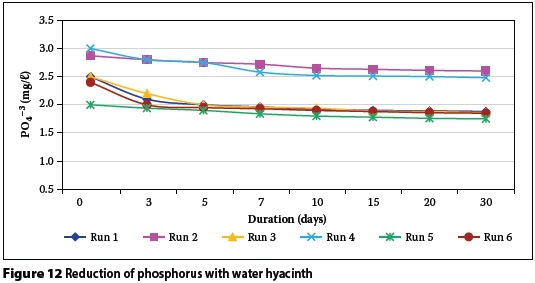
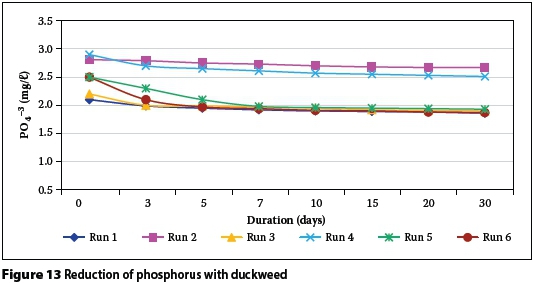
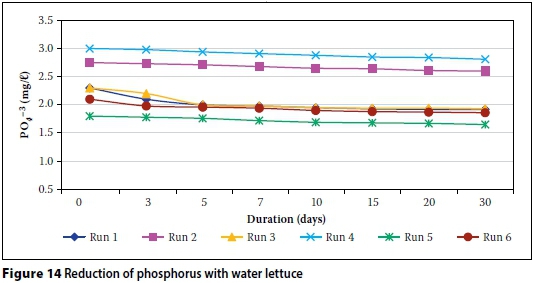
Factors affecting the performance
Temperature
In order to check the performance of macrophytes under various temperature conditions, additional experiments were conducted with pH 7.5. Figure 15 shows the effect of temperature variation on the performance of water hyacinth, duckweed and water lettuce regarding BOD5 removal. During the experiments it was observed that macrophytes are sensitive to temperature and show no growth and pollutant (BOD5) removal at a temperature below 10oC. Almost all of the plants of these three species cease to survive at this temperature. As the growth of species is negligible at temperature below 10oC, there was no uptake of nutrients (N and P) by the plants. A temperature between 15-38oC is suitable for treatment of municipal waste-water by macrophytes, as high growth was observed at this temperature.
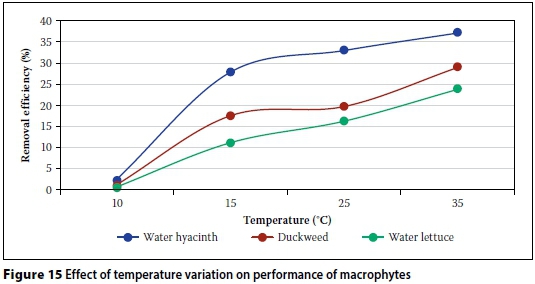
pH
In order to monitor the effect of the variation of pH on the performance of macrophytes, experiments in the laboratory were conducted at a temperature of 25oC and at different levels of pH. At a pH below 5, macrophyte performance (BOD5 removal) is almost zero. This is mainly due to the highly acidic nature of the wastewater. On the other hand, when the pH gradually increases, performance improves up to a pH of 7.5, and, at further increase in pH again starts retarding mac-rophyte performance (BOD5 removal). At a pH of 10 (at high alkalinity) the performance of macrophytes was again decreased to zero. Therefore, a pH of 6-9 is most suitable for the performance of macrophytes. Figure 16 shows the effect of pH variation on the performance of water hyacinth, duckweed and water lettuce regarding BOD5 removal.
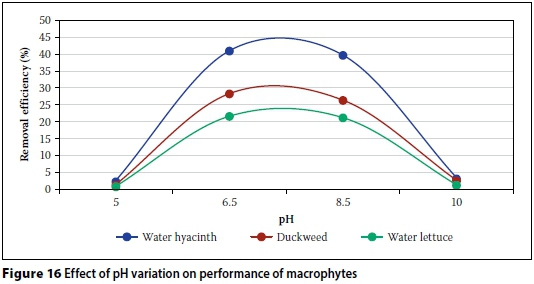
Plant growth
The plant stems filtered and reduced some particles in the wastewater. When they died, they acted as a net that filtered some of the pollutants. They reduced inflow and induced particles accumulation or precipitation in the systems. Plant heights were observed in order to investigate plant growth during each trial. The measured plant heights are given in Table 1.

Plant biomass productivity
Primary productivity and biomass are the important parameters. In general, the productivity of macrophytes is higher than that of terrestrial communities and agricultural crops because they do not suffer from a shortage of water. Macrophytes have a high tolerance for the fluctuations in environmental conditions and show high photosynthetic efficiencies. Uptake of nutrients by macrophytes is essential for their growth and reproduction. The high productivity of macrophytes enables substantial amounts of nutrients to be stored in plant biomass. Measurements of biomass were made after the 5th, 10th, 20th and 30th day of each experimental run for water hyacinth, water lettuce and duckweed. The plant biomass growth in the model was plotted and is shown in Figures 17, 18 and 19. It is quite clear from the results that there was a major rise in plant biomass in the first ten days. However, in the remaining twenty days it was much less when compared to the initial growth.
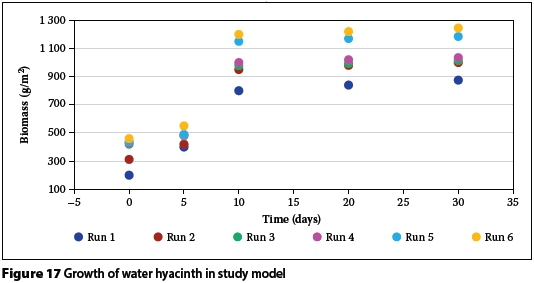
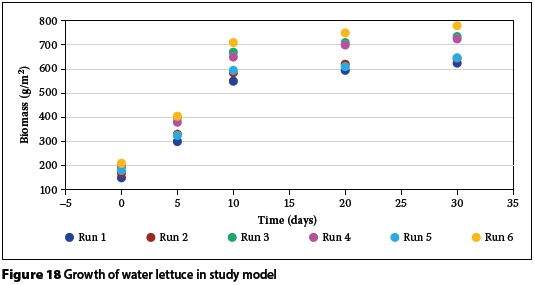
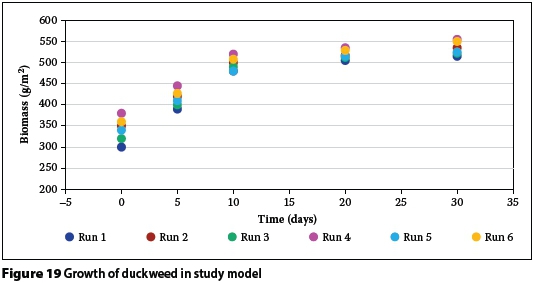
The results showed that the optimum period for harvesting was found to be 8-10 days. At the optimum point, the growth rate of the plant is lowest.
CONCLUSION
As far as removal efficiencies are concerned, water hyacinth was found to be the most effective macrophyte, while considerable removals of pollutants were also found with duckweed and water lettuce. The performance of the water hyacinth-based system was found to be 50.61% for BOD5, 46.38% for COD, 40.34% for nitrogen and 18.76% for phosphorus. For the duckweed-based system the efficiencies were 33.43% for BOD5, 26.37% for COD, 17.59% for nitrogen and 15.25% for phosphorus. Similarly, for water lettuce these values were 33.43% for BOD5, 26.37% for COD, 17.59% for nitrogen and 15.25% for phosphorus. The mechanisms of pollutant removal in the system include both aerobic and anaerobic microbiological conversions, sorption, sedimentation, volatilisation and chemical transformations. The pH of the wastewater affects the performance of macrophytes and it was found that macrophytes gave optimum performance at pH 6-9. Temperature is another factor that severely affects macrophytes performance and it was found that, at a temperature below 10oC, macrophytes were unable to perform treatment and that the favourable temperature for treatment is 15-38oC. Pre-treatment of wastewater before plant acclimatisation could be potentially effective. The harvested macrophytes can be used, directly or after processing, as soil additives, mulch, fertiliser, green manure, pulp and fibre for paper-making, animal feed, human food, organic malts for biogas production, and for composting. The option of macro-phytes for treatment of municipal sewage under local environmental conditions can be explored by further verifying the removal efficiency under different environmental conditions. There is a need for a macrophyte system to be used over time for the treatment of wastewater, because its performance is comparable to that of conventional waste-water treatment plants and, in addition, such a system has very low operation and maintenance costs.
REFERENCES
APHA (American Public Health Association) 2012. Standard Methods for the Examination of Water and Wastewater, 22nd ed. Washington DC: APHA. [ Links ]
Duenas, J F, Alonso, J R, Rey, A F & Ferrer, A S 2003. Characterization of phosphorous forms in wastewater treatment plants. Journal of Hazardous Materials, 97: 1-3. [ Links ]
IWMI (International Water Management Institute) 2004. A framework for global assessment of the extent of wastewater irrigation. The need for a common wastewater typology. Netherlands: International Water Management Institute, p 958. [ Links ]
Metcalf & Eddy Inc. 1991. Wastewater Engineering. New York: McGraw-Hill. [ Links ]
Montaigne, F & Essick, P 2002. Water pressure. National Geographic, 202: 2-23. [ Links ]
Trepanier, C, Parent, S, Comeau, Y & Bouvrette, J 2002. Phosphorous budget as a water quality management tool for closed aquatic mesocosms. Journal of Water Research, 36: 1007-1017. [ Links ]
Polprasert, C 2007. Organic Waste Recycling: Technology and Management, 3rd ed. London: IWA Publishing. [ Links ]
Reed, S C, Middlebrooks, E J & Crites, R W 1988. Natural Systems for Waste Management and Treatment. New York: McGraw-Hill. [ Links ]
Watson, J T, Reed, S C, Kadlec, R H, Knight, R L & Whitehouse, A E 1989. Performance expectations and loading rates in constructed wetlands. In: Hammer, D A (Ed.), Constructed Wetlands for Wastewater Treatment, Chelsea, MI, US: Lewis Publishing. [ Links ]
Wiley, J 2005. Wastewater Microbiology, 3rd ed. New York: McGraw-Hill, p 746. [ Links ]
 Correspondence:
Correspondence:
Mumtaz Shah
c/o Dr Hashim Nisar Hashmi (Prof CED)
Faculty of Civil and Environmental Engineering
University of Engineering and Technology
Taxila, 47080, Pakistan.
T: +92 341 440 0046
E: mumtazshah@gmail.com
Prof Dr Hashim Nisar Hashmi
Faculty of Civil and Environmental Engineering
University of Engineering and Technology
Taxila, 47080, Pakistan. T: +92 321 557 0450
E: drhnh@yahoo.com OR hashim.nisar@uettaxila.edu.pk
Prof Dr Abdul Razzaq Ghumman
Faculty of Civil and Environmental Engineering
University of Engineering and Technology
Taxila, 47080, Pakistan
T: +92 300 522 3338
E: abdul.razzaq@uettaxila.edu.pk
Muhammad Zeeshan
Faculty of Civil and Environmental Engineering
University of Engineering and Technology
Taxila, 47080, Pakistan.
T: +92 346 442 2191
E: zeeshan.m@uettaxila.edu.pk

MUMTAZ SHAH is a PhD candidate in the Civil and Environmental Engineering Department at the University of Engineering and Technology, Taxila, Pakistan. He has 11 years of experience in infrastructure design in various foul sewer projects, and water and treated sewage effluent projects, where he was involved in the preparation of concept design, preliminary design, detail design, and the preparation of engineering design reports. He is well versed in local and international design standards/codes of practice related to water, wastewater and surface water.

PROF DR HASHIM NISAR HASHMI currently works in the Civil and Environmental Engineering Department at the University of Engineering and Technology, Taxila, Pakistan. He obtained his BSc in Civil Engineering from the Engineering University, Lahore, Pakistan, in 1984 (with distinction), and his PhD from the Queens University, United Kingdom, in 1993. He has published many research papers in leading international scientific journals, and in the proceedings of international conferences. He has successfully supervised ten PhD candidates, and has also received the Best Teacher Award from the Higher Education Commission of Pakistan.

PROF DR ABDUL RAZZAQ GHUMMAN currently works at the University of Engineering and Technology, Taxila, Pakistan. He obtained his BSc in Civil Engineering from the Engineering University, Lahore, Pakistan, in 1980, an MPhil in Water Resources Engineering from the same university, and a PhD from the University of London in 1995. He has published about 113 research papers in leading scientific journals and in the proceedings of international conferences. He has successfully supervised six PhD candidates, and he is also a recipient of the Best Teacher Award from the Higher Education Commission of Pakistan.

MUHAMMAD ZEESHAN is currently working as lecturer and laboratory engineer at the University of Engineering and Technology, Taxila, Pakistan. He obtained a BSc in Environmental Engineering from the Engineering University, Lahore, Pakistan, and is now studying towards a Masters in Environmental Engineering. He has a broad interest in water and wastewater treatment, health and safety, and experimental work. He is currently working on industrial wastewater treatment, focusing on reuse and recycling, using technology that involves a membrane bioreactor and bio-fouling reduction.














